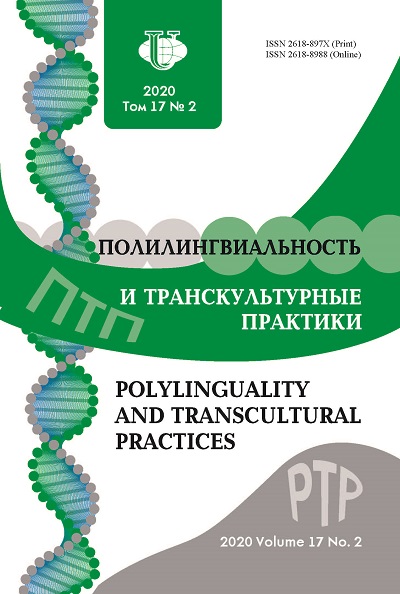To the Readers
- Authors: Bakhtikireeva U.M.1
-
Affiliations:
- Peoples’ Friendship University of Russia
- Issue: Vol 17, No 2 (2020)
- Pages: 136-139
- Section: To our readers
- URL: https://journals.rudn.ru/polylinguality/article/view/24067
- ID: 24067
Cite item
Full Text
Abstract
Full Text
Unlike other journals of the RUDN University of philological orientation, “Polilinguality and Transcultural Practices” (PTP) is intended to publish research materials related to: russophon, English, French, Hispanic fiction and their translations into other languages; translingual and transcultural practices from different perspectives (linguistic, literary, cultural, philosophical, multidisciplinary). Due to the fact that the series was called from 2004 to 2018. “Problems of Education: Languages and Speciality”, until 2015, it published the work of philologists, mainly teachers of Russian and in. languages. From the 3rd issue of 2015, the editorial board and editorial policy changed, and studies devoted to the linguistic analysis of russophon literary texts and translational practices began to be published in the journal. However, some inertial task (2004-2015) also worked in subsequent issues, since many colleagues associate the journal to this day with the problems of teaching the Russian language. From the 4th issue of 2020, studies devoted to the issues of specific national literature or the “pure” methodology will not be published in the PTP. The most important task is the linguistic analysis of transcultural traditions both in the post-Soviet territory and in the world. The journal will specialize in works exploring a fruitful dichotomy, polyglossy, in particular: russophonic literary texts (a unique and symptomatic phenomenon in the world literary, linguistic and more broadly - the cultural configuration of past and present centuries); - Russophonic, Anglophone, Francophone, Spanophonephone continuums (living, dynamic, flexible, open, transcultural traditions that advance both creative personalities that have received world recognition and an infinite number of individual personalities). Most of the volume of each issue will be devoted to Russophony of art (individual) and collective (mass). The editorial board proceeds from the understanding that aesthetic and ontological models of bi-, translingual authors. Works of Russophones differ from authors writing in “native” / ethnic languages by special kind of creative ambivalence. On the one hand, Russophony and following the traditions of Russian literature, on the other hand, some impermeability due to other systems of images (different from Russian). So, the editorial board decided to update the research on the “foreign language being” of biand translingual creative personalities. The methodological base for studying the bilingual and “foreign-language” being of the writers can be the works of well-known philologists and the work of young researchers. The authoritative scientist V.V. Ivanov in “Linguistics of the Third Millennium” notes the relevance of works studying the “verbal evidence” of a person and “individual tragic twists and turns of linguistic fate”, starting from birth (and even embryonic development) up to “linguistic aging” / gerontological linguistics. The famous Russian scholar from Moldova T.P. Mlechko in the “Russian Language Personality of the Near Abroad” emphasizes the importance of research on the identification of typological features of the Russian-speaking personality. Based on linguistic illustrations of modern linguistic personalities specific prototypes, the scientist offers his own method «through the prism of the language to see a person.» The ontology of translingualism the “foreign language being” of ethnically nonRussian, but Russophone authors is studied in the works of other philologists (M.M. Auezov, V.R. Amineva, U.M. Bakhtikireeva, O.A. Valikova, A.B. Tumanova, E.F. Shafranskaya and many others). The list can be continued, including the works of specialists in translingualism of foreign countries (S. Kellman, M.V. Tlostanova, and many others). The understanding of the bilingual and “foreign” life of a concrete creative person is an attempt to understand through the individual typical. Aesthetic-ontological models of bi-, translingual authors, works of Russophones differ from authors writing in “native” / ethnic languages, a special kind of creative ambivalence. On the one hand, Russophony and following the traditions of Russian literature, on the other hand, some impermeability, due to other systems of images other than Russian. Thus, the linguistic identity of biand translational writers provides an opportunity to comprehend and describe the embeddedness of the individual life trajectory “in the entire concrete combination of its twists and turns” (A. Gottlieb) in the social context. As for the specific manifestation of collective (mass) Russophony, preference will be given to articles devoted to the post-Soviet Russian-language continuum which is based on polyglossy - a multitude of language variants and dialects. They are intertwined and constitute a mutually understanding, albeit heterogeneous, “bricolage” linguistic space in which the relativity of the norms of the literary Russian language is clearly manifested. The unclearly defined norm of the literary language, deviations from it and the overlapping of various language variations in oral and written speech are the essence of a special multilingual Russian-language continuum, which is based on the technique of free switching from one version and code to another.×
About the authors
Uldanai M. Bakhtikireeva
Peoples’ Friendship University of Russia
Email: bakhtikireeva-um@rudn.ru
Doctor of Philology, prof. 6, Miklukho-Maklaya str., Moscow, 117198, Russian Federation
References
Supplementary files














